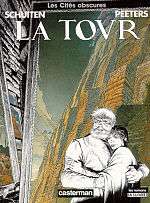La Tour (comics)

La Tour is a graphic novel by Belgian comic artists François Schuiten and Benoît Peeters, the third volume of their ongoing Les Cités Obscures series. It was first published in serialized form in the Franco-Belgian comics magazine À Suivre (#96-106), and as a complete volume first in 1987 by Casterman. In English, it was published as The Tower (Stories of the Fantastic) in 1993 by NBM Publishing.
Background
As the story takes place in the ancient history of the Obscure World, La Tour is the one Les Cités Obscures album exhibiting the least connection to steampunk fiction. Instead, The Tower's design, architecture, and clothing show strong Medieval influences of time periods between the 10th and the 15th centuries, particularly Pre-Romanesque, Romanesque, Gothic, and early Renaissance art. The technology used is therefore more reminiscent of clockpunk.
Plot
We are introduced to Giovanni Battista (whose visual appearance Schuiten based on Orson Welles playing Falstaff in Chimes at Midnight[1]). Battista is a maintenance engineer in The Tower, a gigantic structure with many such engineers, each maintaining his own sector. The time is about 400 AT (Age of The Tower), which is the number of years since The Tower's ongoing construction has begun. Battista lives a solitary life alone in his sector, focused intently on his job and on following its established protocols. His world, like the graphic novel itself, is black and white. But over the years he loses contact with the other maintenance engineers and even with his superiors. His repeated requests for a resupply of materials needed to repair the structure are seemingly ignored. Thus, Battista's sector begins to fall into decay.
Worried about the increasingly decrepit state of his sector, Battista decides to leave his post and to inform his superiors in person. Although he begins the journey on foot, climbing down The Tower, he eventually builds a parachute to speed his descent. But the parachute is caught in an updraft, and Battista is taken even higher in The Tower. There he encounters an autonomous civilization whose technological and architectural level Schuiten locates exactly at the segue between Medieval Gothic art and the early Renaissance period. Like Battista, the inhabitants are following the protocols of the established bureaucracy, and patiently waiting for news from the base of The Tower while their sector decays. One inhabitant, Elias, has a collection of paintings. Unlike the rest of the graphic novel, these painting are in color, and Battista is fascinated by the scenes they depict: of nudity, of war, and most importantly of people motivated by their passions. Having failed to reach the base of The Tower, Battista decides to head upwards, intending to reach the top where pioneers and construction engineers are said to continually advance the building higher and higher.
As Battista reaches the top, he comes upon the shocking revelation that The Tower's continuous construction was abandoned years before. The pioneers apparently left in a hurry, taking everything of value and discarding what was too heavy to carry. The trail of discarded belongings leads Battista to a gigantic winch that was presumably used to lower the pioneers through the hollow center of The Tower to its base. At the bottom, Battista finds piles of riches thrown haphazardly about and abandoned, partially obscuring the exit. Near a discarded picture frame he glimpses some color—what Battista mistakes for a painting is in fact the world outside The Tower.
Battista leaves The Tower behind and gets swept up in a raging war at its base. He kills for the first time in his life, and eventually helps to lead a band of soldiers to victory as the The Tower collapses in the distance behind him. Battista makes a life for himself and rises to a position of some distinction, living happily ever after, but haunted by his memories of The Tower and by the stark contrast between its black-and-white world and the colorful life he now enjoys.
Editions
In French
- La Tour (softcover edition), 1987, Casterman
- La Tour (hardcover edition), 1987, Casterman
- La Tour, 1993, Casterman
- La Tour, 2008, Casterman
In English
- The Tower (Stories of the Fantastic), 1993, NBM Publishing
External links
- La Tour, a few annoted pictures from the album (French)
- Series overview on A comprehensive review of the Obscure Cities series for English-speaking fans
- Les Cités Obscures by Juliani Darius on The Continuity Pages
References
- ↑ Dossier FRANCOIS SCHUITEN, in Reddition - Zeitschrift für Graphische Literatur, #32, 1998, p.22 (German)